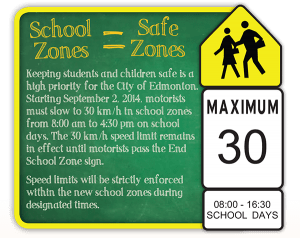Improving safety in school zones
Child safety is crucial, which is why city council reintroduced school zones in 2014 with reduced speed limits. With many near misses, complaints to EPS, bylaw, and the Office of Traffic Safety (OTS), as well as some child pedestrian collisions, it was clear more needed to be done.
Gerry Shimko, director of OTS, commissioned a pilot study using a new video analytics tool created by Dr. Tarek Sayed from the University of British Columbia on one of Edmonton’s high risk school zones: Dr. Donald Massey School. The pilot was a success. After collecting the video data in both fall and winter in the school zone, the data was assessed by Sayed and Shewkar Ibrahim, a road safety engineer. The assessment highlighted many areas for improvement and safety counter measures were installed.
Upgrades included flashing crosswalk beacons, zebra line markings, pavement markings, driver speed display signs, reflective tape stop sign and crosswalk poles. Yield signs were also upgraded to stop signs along with continued enforcement. According to Ibrahim, “We have received positive feedback from the principal, from students, and from parents.” The Office of Traffic Safety hasn’t received any complaints regarding this school zone since upgrades.

Traditional assessments use incomplete or unreliable collision data, along with site visits that provide a glimpse of problems in the area. According to Ibrahim, the video analytics tool was successful because multiple factors can be assessed at once by reviewing conflicts.
A conflict is when there is a near miss in traffic that could lead to a collision. Conflicts occur more often than collisions. They can provide more information about what is happening at that location, such as confusing signage or road geometry, U-turns, double parking and jaywalking. As Ibrahim puts it, conflicts provide “insight into why road users are behaving the way they do.” The tool identifies how close these near misses are to collisions and what can be done to prevent further conflicts.
Given the pilot’s success, city council expanded this project to include multiple schools as part of the Vision 2020 Road Safety Strategy. The plan will allow OTS to assess 13 school zones this year and 24 school zones for each of the next four years. A total of 109 schools will be assessed and upgraded.
Delton Elementary School is identified as a priority school for assessment. Although no date has been set, Delton is on the list and will be completed before 2017.
Once the Delton school zone upgrades are complete, drivers will have better indicators regarding crosswalks, the speed they are travelling and where to stop safely. Pedestrians, particularly students, will have better visibility and protections when crossing the street. Given the recent child struck in the crosswalk by this school, these upgrades may have helped in preventing this collision.
Any questions relating to this project can be directed to the OTS via email: saferoads@edmonton.ca







